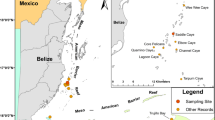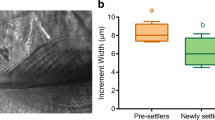Abstract
Two demersally-spawning fishes were selected to examine the relationship between adult spawning strategies and the early life histories of larvae and juveniles. Although the Caribbean gobies, Coryphopterus glaucofraenum Gill and Gnatholepis thompsoni Jordan are common, co-occurring constituents of nearshore coral reefs, relatively little is known about the early life history and recruitment of their pelagic larvae to the reef environment. To examine patterns of recruitment, recently settled juveniles (7.5 to 16 mm standard length, SL) were censused and collected biweekly from reefs of Barbados, West Indies, during the spring recruitment peak for 3 yr (March to June 1990 to 1992). Otolith analyses were used to determine larval durations and to back-calculate settlement patterns and spawning dates. G. thompsoni spent more than twice as long in the plankton (60 d) than did C. glaucofraenum (27 d). Variation in larval duration of G. thompsoni [coefficient of variation (CV)=22.4%; durations up to 112 d] was significantly greater than that of C. glaucofraenum (CV=9.4%), which suggests that G. thompsoni has a greater capacity for delaying settlement and metamorphosis. Estimated size at settlement for G. thompsoni (SL=8.4 mm) was significantly larger than for C. glaucofraenum (SL=6.4 mm), but post-settlement growth rates were virtually identical (0.21 to 0.22 mm d−1). Settlement of both gobies occurred predominantly around the third quarter moon (ca. Day 21 to 22), but there was much greater spread in the settlement of C. glaucofraenum. Back-calculated spawning frequency for C. glaucofraenum was not closely linked to the lunar cycle, whereas spawning of G. thompsoni occurred more frequently during the third quarter moon. These observations demonstrate that two confamilial demersal spawners may have larvae with contrasting life history traits which can influence patterns of juvenile recruitment. A secondary peak in larval duration of G. thompsoni approximately 1 mo after the major mode (Day 87) suggests that if settlement does not occur two lunar cycles after hatching, G. thompsoni larvae may delay settlement until the following third quarter moon. This coupling suggests that settlement during a particular lunar phase may be advantageous for new recruits, and the capacity to delay metamorphosis may enable tighter synchronization to the lunar cycle.
Similar content being viewed by others
References
Barlow GW (1981) Patterns of parental investment, dispersal and size among coral-reef fishes. Environ Biol Fish 6: 65–85
Batschelet E (1981) Circular statistics in biology. Academic Press, New York
Boehlert G, Watson W, Sun LC (1992) Horizontal and vertical distribution of larval fishes around an isolated oceanic island in the tropical Pacific. Deep-Sea Res 39: 439–466
Boekhoudt BG (1992) The effect of current shifts on larval fish distributions around Barbados. M.S. Thesis, State University of New York, Stony Brook
Bohlke JE, Chaplin CCG (1968) Fishes of the Bahamas and adjacent waters. Livingston Publishing Co., Wynnewood
Brothers EB (1987) Methodological approaches to the examination of otoliths in aging studies. In: Summerfeldt RC, Hall GE (eds) Age and growth of fish. Iowa State University Press, Des Moines, pp 319–330
Brothers EB, Mathews CP, Lasker R (1976) Daily growth increments in otoliths from larval and adult fishes. Fish Bull US 74: 1–8
Brothers EB, McFarland WN (1981) Correlations between otolith microstructure, growth, and life history transitions in newly recruited French grunts (Haemulon flavolineatum Desmarest: Haemulidae). Rapp P-v Reun cons int Explor Mer 178: 369–374
Brothers EB, Williams DMcB, Sale PF (1983) Length of larval life in twelve families of fishes at “One Tree Lagoon”, Great Barrier Reef, Australia. Mar Biol 76: 319–324
Campana SE, Jones CM (1992) Analysis of otolith microstructure data. In: Stevenson DK, Campana SE (eds) Otolith microstructure examination and analysis. Can Spec Publ Fish aquat Sciences 117
Campana SE, Neilson JD (1985) Microstructure of fish otoliths. Can J Fish aquat Sciences 42: 1014–1032
Cole KS, Shapiro DY (1992) Gonadal structure and population characteristics of the protogynous goby Coryphopterus glaucofraenum. Mar Biol 113: 1–9
Colin PL (1975) Neon gobies. T.F.H. Publishers, Neptune City
Colin PL, Clavijo IE (1988) Spawning activity of fishes producing pelagic eggs on a shelf edge coral reef, southwestern Puerto Rico. Bull mar Sci 43: 249–279
Cowen RK (1991) Variation in the planktonic larval duration of the temperate wrasse Semicossyphus pulcher. Mar Ecol Prog Ser 69: 9–15
Cowen RK, Castro LR (1994) Relation of coral reef fish larval distributions to island scale circulation around Barbados, West Indies. Bull mar Sci 54: 228–244
Doherty PJ (1983) Diel, lunar and seasonal rhythms in the reproduction of two tropical damselfishes: Pomacentrus flavicauda and P. wardi. Mar Biol 75: 215–224
Doherty PJ, Williams DMcB (1988) The replenishment of coral reef fish populations. Oceanogr mar Biol A Rev 26: 487–551
Doherty PJ, Williams DMcB, Sale PF (1985) The adaptive significance of larval dispersal in coral reef fishes. Environ Biol Fish 12: 81–90
Fournier DA, Sibert JR, Majkowski J, Hampton J (1990) MULTIFAN a likelihood-based method for estimating growth parameters and age composition from multiple length frequency data sets illustrated using data for southern bluefin tuna. Can J Fish aquat Sciences 47: 301–317
Fowler AJ (1989) Description, interpretation and use of the microstructure of otoliths from juvenile butterflyfishes (family Chaetodontidae). Mar Biol 102: 167–181
Gladstone W, Westoby M (1988) Growth and reproduction in Canthigaster valentini (Pisces, Tetradontidae): a comparison of a toxic reef fish with other reef fishes. Environ Biol Fish 21: 207–221
Johannes RE (1978) Reproductive strategies of coastal marine fishes in the tropics. Environ Biol Fish 3: 65–84
Kingsford MJ (1980) Interrelationships between spawning and recruitment of Chromis dispilis (Pisces: Pomacentridae). M.S. Thesis, University of Auckland, Auckland
Kingsford MJ, Milicich M (1987) Presettlement phase of Parika scaber (Pisces: Monocanthidae): a temperate reef fish. Mar Ecol Prog Ser 36: 65–79
Labelle M, Nursall JR (1992) Population biology of the redlip blenny, Ophioblennius atlanticus macclurei (Sylvester) in Barbados. Bull mar Sci 50: 186–204
Lassig B (1976) Field observations on the reproductive behaviour of Paragobiodon spp. (Osteichthys: Gobiidae) at Heron Island, Great Barrier Reef. Mar Behav Physiol 3: 283–293
Laws EA, Archie JW (1981) Appropriate use of regression analysis in marine biology. Mar Biol 65: 13–16
Leis JM (1991) The pelagic stage of reef fishes: the larval biology of coral reef fishes. In: Sale PJ (ed) The ecology of fishes on coral reefs. Academic Press, New York, pp 183–230
Lubbock R (1980) The shore fishes of Ascension Island. J Fish Biol 17: 283–303
Luckhurst BE, Luckhurst K (1977) Recruitment patterns of coral reef fishes on the fringing reefs of Curacao, Netherlands Antilles. Can J Zool 55: 681–689
Maddox E (1992) Generic identification and patterns of external pigment in larval gobies (Pisces: Gobiidae) from the Belize barrier reef. M.S. Thesis, College of William and Mary, Virginia
McFarland WN, Brothers EB, Ogden JC, Shulman MJ, Bermingham EL, Kotchian-Prentiss NM (1985) Recruitment patterns in young French grunts, Haemulon flavolineatum (Family Haemulidae), at St. Croix, Virgin Islands. Fish Bull US 83: 413–426
Moe MA Jr (1975) Propagating the Atlantic neon goby. Mar Aquarist 6: 4–10
Munro JL, Gaunt VC, Thompson R, Reeson PH (1973) The spawning seasons of Caribbean reef fishes. J Fish Biol 5: 69–84
Ochi H (1985) Temporal patterns of breeding and larval settlement in a temperate population of the tropical anemonefish, Amphiprion clarkii. Jap J Ichthyol 32: 248–257
Pechenik JA (1990) Delayed metamorphosis by larvae of benthic marine invertebrates: does it occur? Is there a price to pay? Ophelia 32: 63–94
Pitcher CR (1988) Validation of a technique for reconstructing daily patterns in the recruitment of coral reef damselfish. Coral Reefs 7: 105–111
Powles H (1975) Abundance, seasonality, distribution and aspects of the ecology of some larval fishes off Barbados. Ph.D. Dissertation, McGill University, Montreal
Radtke RL, Kinzie RA, Folsom SD (1988) Age at recruitment of Hawaiian freshwater gobies. Environ Biol Fish 23: 205–214
Ricker WE (1973) Lincar regressions in fisheries research. J Fish Res Bd Can 30: 409–434
Robertson DR (1992) Patterns of lunar settlement and early recruitment in Caribbean reef fishes at Panama. Mar Biol 114: 527–537
Robertson DR, Green DG, Victor BC (1988) Temporal coupling of production and recruitment of a larvae of a Caribbean reef fish. Ecology 69: 370–381
Robertson DR, Petersen CW, Brawn JD (1990) Lunar reproductive cycles of benthic-brooding reef fishes: reflections of larval biology or adult biology? Ecol Monogr 60: 311–329
Schmitt PD (1984) Marking growth increments in otoliths of larval and juvenile fish by immersion in tetracycline to examine the rate of increment formation. Fish Bull US 82: 237–242
Sokal RR, Rohlf FJ (1981) Biometry. W. H. Freeman, San Francisco
Thresher RE (1984) Reproduction in reef fishes. T.F.H. Publications, Neptune City
Thresher RE, Brothers EB (1985) Reproductive ecology and biogeography of Indo-West Pacific angelfishes (Pisces: Pomacanthidae). Evolution 39: 878–887
Thresher RE, Brothers EB (1989) Evidence of intra- and inter-oceanic regional differences in the early life history of reef-associated fishes. Mar Ecol Prog Ser 57: 187–205
Thresher RE, Colin PL, Bell L (1989) Planktonic duration, distribution and population structure of western and central Pacific damselfishes (Pomacentridae). Copeia 1989: 420–434
Thorrold SR (1988) Estimating some early life history parameters in a tropical clupeid, Herklotsichthys castelnaui, from daily increments in otoliths. Fish Bull US 87: 73–83
Victor BC (1982) Daily otolith increments and recruitment in two coral-reef wrasses, Thalassoma bifasciatum and Halichoeres bivittatus. Mar Biol 71: 203–208
Victor BC (1986a) Delayed metamorphosis with reduced larval growth in a coral reef fish (Thalassoma bifasciatum). Can J Fish aquat Sciences 43: 1208–1213
Victor BC (1986b) Larval settlement and juvenile mortality in a recruitment-limited coral reef fish population. Ecol Monogr 56: 145–160
Victor BC (1986c) Duration of the planktonic larval stage of one hundred species of Pacific and Atlantic wrasses (family Labridae). Mar Biol 90: 317–326
Victor BC (1991) Settlement strategies and biogeography of reef fishes. In: Sale PJ (ed) The ecology of fishes on coral reefs. Academic Press, New York, pp 231–260
Wellington GM, Victor BC (1989) Planktonic larval duration of one hundred species of Pacific and Atlantic damselfishes (Pomacentridae). Mar Biol 101: 557–567
Wilkinson L (1990) SYSTAT: The system for statistics. SYSTAT, Inc., Evanston
Zar JH (1984) Biostatistical analysis. Prentice-Hall, Englewood Cliffs
Author information
Authors and Affiliations
Additional information
Communicated by J. P. Grassle, New Brunswick
Rights and permissions
About this article
Cite this article
Sponaugle, S., Cowen, R.K. Larval durations and recruitment patterns of two Caribbean gobies (Gobiidae): contrasting early life histories in demersal spawners. Mar. Biol. 120, 133–143 (1994). https://doi.org/10.1007/BF00381949
Received:
Accepted:
Issue Date:
DOI: https://doi.org/10.1007/BF00381949




